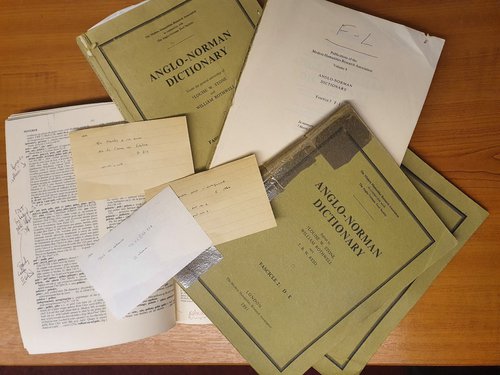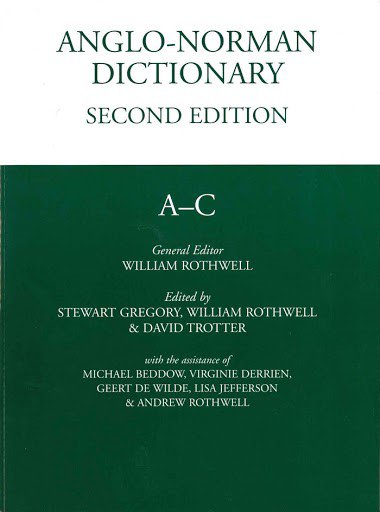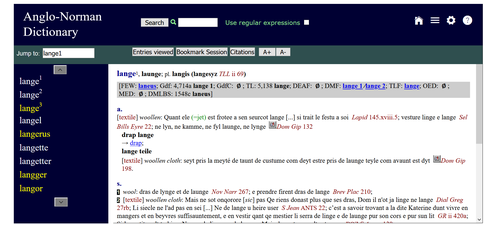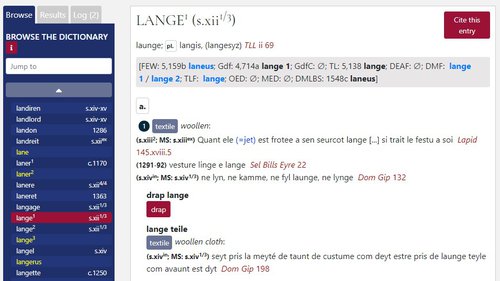Anglo-Norman Dictionary : Recent Developments
In anticipation of the unveiling of the new version of the Anglo-Norman Dictionary website expected by the end of December 2020, Geert De Wilde, Editor and Project Leader of the Anglo-Norman Dictionary, Aberystwyth, reflects on the latest developments at the AND and the new features that will soon become available.
Writing a dictionary of any language is always going to be a mammoth task: it usually is the effort of a team of people, compiling and processing lexicographical data over many decades, and publishing their findings in fascicules or multiple volumes. The Anglo-Norman Dictionary, the primary resource for documenting the French language as it was used in medieval Britain, is no exception – even though it is sometimes considered as one of the ‘faster’ dictionaries to be written.
What is ‘fast’? The idea to compile a dictionary specifically of Anglo-Norman lexis goes back to the late 1940s, and the results were published in 7 volumes between 1977 and 1992.
The editors at the time had already come to realise that their dictionary was inherently incomplete even before it was finished: the first four volumes (A-O/U) focussed almost exclusively on literary texts, and it was only from P onwards that concerted efforts were made to include the rich field of non-literary sources (such as parliament rolls, court proceedings, customs documents, wills, statutes, etc.). The rectification of this imbalance – and the inclusion of this very large body of sources – was one of the main reasons for starting the Second Edition (AND2) in late 1990s.
It was in 2005 that the first outcome of this – two volumes of AND2 (A-E) – was published.

Figure 1: William Rothwell’s annotated copy of the first edition of the Anglo-Norman Dictionary
By this time, another change had taken place, as it was decided to refocus the AND as a purely digital resource, freely available on-line. The site (www.anglo-norman.net) was first opened to the general public in March 2006, and presented the second edition of A-F (one revised letter extra compared to the printed version) in combination with the first edition of G-Z. For the last 17 years, I have been part of the team of three or more editors that is carrying out AND2’s thorough and complete revision. We publish roughly one letter of the alphabet per year on the website, each time replacing the equivalent AND1 section with new AND2 entries. We have now reached the letter R, which will be published later this month.

Figure 2: Volume 1 of the printed edition of the second edition, AND2
One of the characteristics of running a long-term dictionary project is that it is inevitably going to develop and even change over time: the editorial team goes through changes, new source materials are discovered or become available, new functionalities are added, and perceptions of what should, or should not, be included in the dictionary may change. This is certainly the case for Anglo-Norman and the AND.
Fortunately, a digital dictionary is ideally placed to absorb these changes, as it can go back and incorporate new material and new features in sections previously completed. For example, in 2018-19 we added S Alexis (1) and the works of Wace (2) to the AND sources, resulting in close to 1000 new citations and 50+ new entries A-Q. In 2013 we provided every AND entry with references to cognate dictionaries of English, (Continental) French and Latin, opening our entries to a wider field of multilingualism. These were also added retrospectively to all AND2 entries already published.
This, of course, increases the workload of the editorial team: not only do we progress slowly through the alphabet so as to produce the ongoing AND2 revision, but we also set time aside to improve upon and expand the earlier sections. Aside from, obviously, being able to go back and correct earlier mistakes instantly (and if you see any, please don’t hesitate to contact us on anglonormandictionary@gmail.com), we can easily change, add or remove citations or even whole entries. Our focus remains on the progressive publication of the AND2 revision, but in the last decade in particular we have implemented some dictionary-wide changes.
As some users will have undoubtedly noticed, however, there have been some technical difficulties with the AND website in recent months, with some functionalities currently inaccessible. We would like to apologise for this uncharacteristic unreliability!
Unfortunately, Michael Beddow, who was the site-developer and provided ongoing technical support for the last 20 years, became ill and passed away in 2019. Since then, and in order to safeguard the AND for the future, it has been necessary to migrate all contents to a newly built site/format. We are happy to say that this time-consuming task is now nearing its completion: Stage 1 of the launch of the new site, focussing on the dictionary itself, is planned to take place later this month (together with the publication of R).
We are seizing the opportunity to update the site’s overall look to twenty-first century standards and re-arrange some of its organisation, as well as to introduce a number of significant new features and functionalities for the user.

Figure 3: Section of the entry lange1 in the online AND2 (accessed 4 December 2020)
As they will become available soon, I would like to already highlight some of them:
The ‘advanced search’ section will bring together three ancillary options to access the dictionary contents. These are already available on the current site, but will become more streamlined and effective:
- ‘English Translations’ will allow users to search for words or parts of words (using wildcard options) in all English definitions. This option can be used to translate English into Anglo-Norman, and effectively turns the AND into a two-way dictionary.
- ‘Citations’ also offers the option of a wildcard search, this time covering all Anglo-Norman citations, thus turning the 155,000+ citations of the dictionary into a massive corpus.
- ‘Semantic and usage labels’ will allow users to search through specific semantic fields and identify onomasiological groups. For example, a palaeographer trying to identify the name of a tree or the word for a piece of armour in his or her manuscript, will be able do a search for the semantic tag ‘tree’ or ‘armour’, and have the AND focussing only on entries for trees or pieces of armour.

Figure 4: The AND Logo
What will be entirely new is that these three options will now also have a chronological dimension, which will allow users to specify any particular period of time: they can, for example, search very specifically for shipping terminology that is attested between 1275 and 1325 in AND citations (through the ‘Semantic and Usage Labels’ search), or fifteenth-century words for ‘dagger’ (through the ‘English Translation’ search).
This chronological element is the result of what is probably one of the most significant changes to the AND: the gradual conversion to a Historical Dictionary. Work on this started almost 4 years ago, and the first results will be published together with the launch of the new website.
In origin the AND was a semantic dictionary: it defines and structures the meanings of a word, usually beginning with the etymological root sense, and expanding this with related subsenses and/or further senses. The primary function of the citations has been to support these definitions: they are selected on the basis of their suitability to illustrate particular meanings. This was the original approach of the AND, which was followed for many decades. Sometime during AND2, some efforts were made to try and capture the earliest citation of a word, even though this was by no means done systematically. It became more and more obvious that many users regretted the lack of a chronological element (indication of the earliest attestation and development of words/senses over time) or – what was worse – assumed that there was one! Our growing expertise in lexicography and, most of all, the flexibility of the digital format of the AND has allowed us to finally address this by returning to and expanding upon the work of the last 20 years, thus bringing AND2 in line with cognate dictionaries such as the OED, MED, DMLBS or DMF.
Practically, the AND will remain primarily a semantic dictionary, but with new and prominent elements of a historical dictionary:
- all citations throughout the dictionary will now carry a date (both of composition and of the manuscript)
- citations will be presented in chronological order per sense, ideally with two or more citations per century in which the word was used
- the earliest sources have been fully re-gleaned, which enabled us to add several thousands of citations to entries A-R that illustrate the first attestation of every word/sense
- since the earliest attestation may not always be used in the primary sense of the word (and may be hiding within an entry), its date will be displayed prominently next to the headword of each entry as well as in the browsable list of headwords
To illustrate this, Figure 5 is a preview of what an entry with dates will look like (with the caveat that changes may still be made between now and publication on the new site later this month):
It should be noted that the ‘earliest attestation’ is, of course, only that until an earlier one is found. This means that we will rely on the flexibility of the online format to keep adding new citations to earlier parts of AND2 as and when needed. The full conversion of the AND to a historical dictionary will remain a work in progress for years, if not decades, to come – as it is, indeed, for all historical dictionaries.

Figure 5: Preview of a section of the entry lange1 in AND2 prepublication (accessed 3 December 2020)
Notes:
(1) Christopher Storey, La vie de Saint Alexis, Texte du Manuscrit de Hildesheim (L), Publié avec une Introduction historique et linguistique, un Commentaire et un Glossaire complet, Textes Littéraires Français, Genève, 1968.
(2) Ivor Arnold, Le Roman de Brut de Wace, 2 vols, SATF, Paris, 1938-40. W. R. Ashford, The Conception Nostre Dame of Wace, Chicago, 1933. A. J. Holden, ‘Le Roman de Rou’ de Wace, 3 vols, Paris, 1970-73, vol. 1, 161-281 and vol. 2 1160-74. Elizabeth A. Francis, Wace, ‘La vie de sainte Marguerite’, Paris, 1932. Einar Ronsjö, ‘La Vie de Saint Nicolas’ par Wace, Poème religieux du XIIe siècle, Études romanes de Lund 5, Lund, 1942.